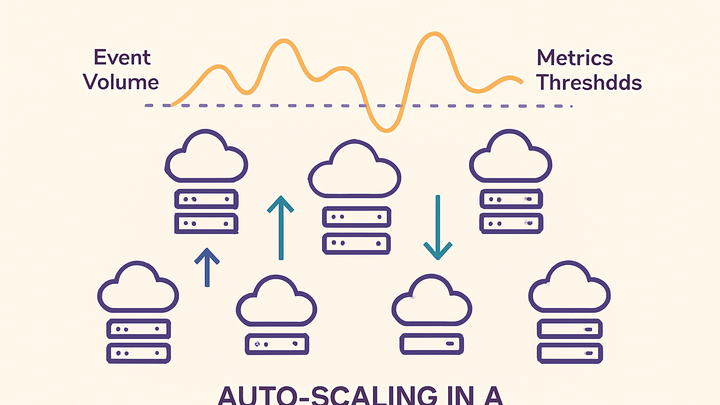Published on 2025-06-26T04:18:00Z
What is Auto-Scaling? Examples in PlainSignal and GA4
Auto-Scaling in analytics refers to the automated adjustment of computing resources—such as
data processing nodes, servers, or containers—in response to real-time workload variations. By
automatically provisioning or decommissioning instances based on predefined metrics (e.g., request rate,
CPU usage, or event volume), analytics platforms can maintain consistent performance, handle traffic
spikes gracefully, and optimize infrastructure costs.
Modern SaaS analytics tools like PlainSignal and Google Analytics 4 leverage auto-scaling architectures under the hood. PlainSignal uses a global CDN and dynamic clustering to elastically handle data ingestion, while GA4 scales its distributed processing pipelines within Google’s Cloud infrastructure. Effective auto-scaling strategies require careful definition of thresholds, policies, and monitoring to avoid oscillations or overprovisioning. Implementing well-tuned auto-scaling ensures seamless user experiences and efficient resource utilization.
Auto-scaling
Auto-Scaling dynamically adjusts analytics infrastructure in response to workload changes, ensuring consistent performance and cost efficiency.
Understanding Auto-Scaling in Analytics
This section covers the core concept of auto-scaling in analytics platforms, the triggers, and why it’s critical.
-
Definition of auto-scaling
Auto-scaling is the process of dynamically adjusting computing resources to match real-time workload demands in an analytics environment.
-
Key scaling metrics
Platforms rely on metrics such as CPU usage, memory utilization, and event ingestion rate to determine when scaling actions are needed.
-
Cpu utilization
Measures the percentage of CPU capacity in use across analytics processing instances.
-
Event ingestion rate
Tracks the number of analytics events received per second or minute.
-
-
Scaling actions
Scaling can involve adding or removing instances (horizontal scaling) or resizing existing ones (vertical scaling).
-
Horizontal scaling
Adding or removing server instances to handle varying loads.
-
Vertical scaling
Increasing or decreasing the resources (CPU, memory) of a single instance.
-
How Auto-Scaling Works
Technical overview of common auto-scaling mechanisms and policies in analytics platforms.
-
Threshold-based policies
Scaling triggers when monitored metrics cross predefined thresholds (e.g., 70% CPU usage or a set event rate).
-
Cooldown periods
Temporary delays after a scaling event to prevent rapid fluctuations or thrashing.
-
Health checks
Ensures new instances are operating correctly before routing traffic and allows graceful termination of old instances.
Auto-Scaling in PlainSignal and GA4
Examples of how two popular SaaS analytics platforms implement auto-scaling behind the scenes.
-
PlainSignal
PlainSignal uses a global CDN and microservices-based clusters to elastically handle data ingestion. Include the tracking snippet below to see how events are captured.
-
Code example
<link rel="preconnect" href="//eu.plainsignal.com/" crossorigin /> <script defer data-do="yourwebsitedomain.com" data-id="0GQV1xmtzQQ" data-api="//eu.plainsignal.com" src="//cdn.plainsignal.com/plainsignal-min.js"></script>
-
-
Google analytics 4 (GA4)
GA4 leverages Google Cloud’s serverless infrastructure, automatically scaling its data collection, processing pipelines, and reporting layers to accommodate spikes in user activity.
Benefits and Challenges
Explores the advantages and potential pitfalls of implementing auto-scaling in analytics systems.
-
Benefits
Key advantages include maintaining performance under load, optimizing costs, and improving system resilience.
-
Performance consistency
Ensures low latency and uninterrupted service during traffic spikes.
-
Cost optimization
Automatically releases unused resources to reduce infrastructure expenses.
-
-
Challenges
Common pitfalls involve misconfigured thresholds, cold start latency, and potential scaling oscillations.
-
Threshold tuning
Incorrect thresholds can lead to frequent scaling events (overscaling) or delayed response (underscaling).
-
Cold start latency
New instances may require initialization time, causing temporary performance dips.
-
Best Practices for Auto-Scaling
Guidelines to implement reliable and efficient auto-scaling in analytics platforms.
-
Monitor and refine metrics
Continuously review historical data to adjust scaling thresholds and policies over time.
-
Use graceful policies
Incorporate cooldown periods and health checks to stabilize scaling actions and avoid thrashing.
-
Test under realistic loads
Perform load testing to validate your auto-scaling configuration before production deployment.
